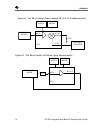
SWRA004A
68 TRF1500 Integrated Dual-Band RF Receiver User’s Guide
a) On the front panel, press the ENR button.
b) Check the ENR value by pressing the Enter button or enter
the ENR value for each frequency.
c) After entering the ENR for the desired frequency, press the
Frequency button on the front panel to exit.
5) To calibrate the NF Meter:
a) Connect the Noise Source directly to the NF meter; press
the calibration button twice.
b) Next, press the Noise Figure and Gain Button. The
corrected LED just above the button should be lit.
c) Calibration is complete. Enter the desired IF frequency to
measure.
Next, the external equipment Loss is considered (RF cable,
Transmission line, filter and circulator).
6) The losses are entered in the Noise Figure Meter by using
special function 34.x.
a) Special Function 34.1 turns on the loss compensation
factor.
b) Special Function 34.2 is used to enter the loss before the
DUT.
c) Special Function 34.3 is used to enter the room
temperature in Kelvin (300
°
K).
d) Special Function 34.4 is used to enter the loss after the
DUT.
e) Special Function 34.0 is used to turn off the loss
compensation factor.
The noise figure is measured as follows:
7) Connect the noise source directly to the EVM RF input port,
J15.
a) A circulator between the noise source and RF input port
may help minimize any mismatches between the EVM
board and test equipment.
8) Connect the LO source to the EVM LO input port, J12.
a) Set the LO source at the nominal power and frequency
(See Table 8).
b) Each LO frequency being tested is entered in the Noise
figure meter by using Special function 3.1. If the source
has excessive broad band noise, a filter at the LO port,


















